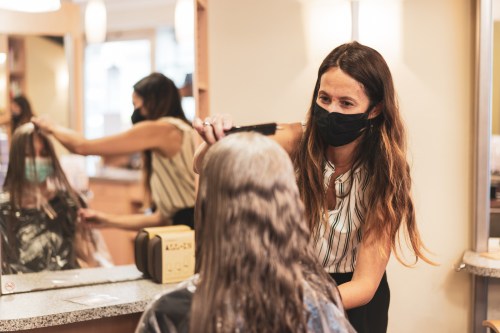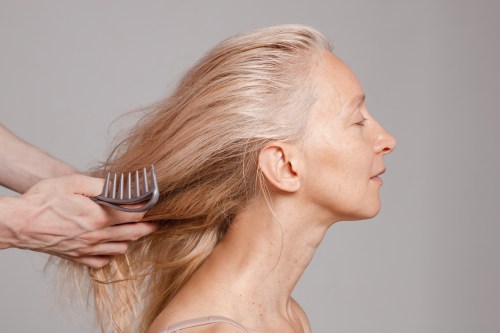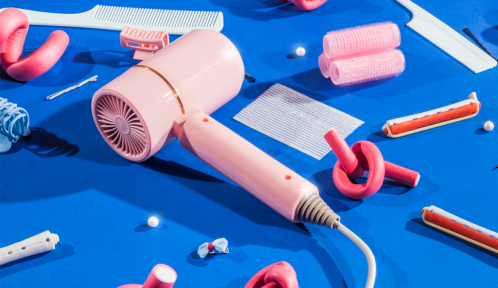What the New Normal of Beauty Salons Post-COVID-19 Is Going to Look Like
Industry experts discuss what beauty salons post-COVID-19 are going to look like, what protocols will be enforced, and how the industry will change.

After almost three months of quarantine, beauty salons have started to reopen. As many people have spent this time becoming their very own personal hairstylist, nail technician, and facialist—for better or for worse—being able to finally book that salon appointment is a moment many of us have waited for. But beauty salons post-COVID-19 are going to look pretty different than what you’re used to.
While new protocols are going to vary by state and salon, the over-arching safety precautions consist of the same basic rules: extra sanitizing and hand washing, fewer people inside of the salon, barrier protection of some sort, and added space between customers. According to guidelines set by the Centers for Disease Control, social distancing is “one of the best tools” that people have in order to risk the spread of infection, and maintaining six feet between yourself and others is the golden rule. Though not all beauty salons have enough space to separate customers that far apart, most are taking other precautions in order to keep infection risks low. Here’s what the new world of hair, nail, and facial services is going to look like.
The post-COVID-19 protocols that beauty salons are implementing
As of May 15, national hairstyling salon Drybar has opened about 50 percent of its locations across the country. Inside, the company is prioritizing a six feet distance rule between washing drying stations, temperature checks, and that everyone inside of the salon wear a protective mask at all times. “Our new protocols were developed based on CDC guidance and healthcare professionals, and we’re staying attuned to any new guidelines that unfold throughout the process,” says Courtney Gruber, chief retail officer of Drybar. So your blow-drying sesh will feel relatively normal, minus the new practice of wearing a face mask.
With facial treatments, of course, you can’t receive a full treatment if half of your face is covered. At Heyday, a facial boutique with locations in New York, California, and Philadelphia, skin therapists will be wearing both a face mask and face shield to prevent the transmission of droplets between people. This is in addition to required temperature checks, health questionnaires for both team members and clients, an appointment-only policy (no walk-ins), and staggered appointments and employee schedules.
Besides that, Michael Pollak, Heyday’s co-founder and chief experience officer, points out that the spa industry in particular has always had strict sanitization rules. “It’s pretty standard in the spa industry to implement medical-grade sanitation,” he says. “Most aesthetic programs and schools train highly on sanitization.”
As far as your manicures go, expect more single-use equipment to be used and fewer technicians in salons at a given time. Vanity Projects, a nail salon in New York City, is requiring that all customers wear masks, and nail artists to wear a mask and gloves. Nail files and buffers will be single-use only, and hand sanitizer will be at every single station inside. The salon is also asking that clients come alone without any guests in the interest of reducing the total number of people inside.
From a safety standpoint, though some people may want their hair or nails done, there is still some fear with the risk of infection, especially when in an indoor space. But these general protocols that beauty salons are taking are pretty on point with what the CDC and experts recommend. “As with any situation where you have a gathering of people who are going to be within six feet-distance of one another, you want to be sure there is ample barrier protection,” says Jason Tetro, microbiologist and author of The Germ Files. “When it comes to these professionals, many of them have already had masks and gloves to ensure their safety. This should continue and expand to other realms as well.”
How beauty salons post-COVID-19 are going to look
For Eric Vaughn, Matrix artistic ambassador and hair salon owner in Houston, Texas, the response from clients has been very positive ever since he opened his doors in May. “The number one thing our clients have said to us is how safe they feel, and that they can definitely tell that the protocol we put in place is there for their safety and comfort,” he says. “A lot of our clients have honestly just been excited to be out of their house and doing something that is somewhat normal, and to feel like we aren’t in the middle of a pandemic.”
Though face masks and added space between others will be mandatory inside of salons—and in every indoor public space, really–you can expect to go back to enjoying your hair and nail appointments like before. Pollak actually sees PPE (personal protective equipment) as something that a lot of beauty services might keep permanently. “It reduces the transmission of anything—no one wants to risk a sick day or catch a common cold, so I see it being more normal across our industry,” he says.
To minimize contact between people, some beauty salons are starting to use technology for tasks that used to be done manually—something that Pollak also sees as having staying power in the industry, since it makes things easier for both customers and the salon. “We’re going to be using more technology to our advantage, which is an exciting improvement regardless,” he says. One such upgrade is that in lieu of skin therapists walking clients through the skin-care products they discussed during treatment in the shop area, products will be virtually added to cart so that when clients leave, they can decide what they want to take. “We’re trying to look at it as glass half full. Using technology to actually deliver a better experience is something that could be a good win for everybody,” says Pollak.
It’s important to remember, not just in terms of beauty salons reopening, but with everything: There isn’t a 100-percent effective way to prevent the spread of infection when you’re around others. “Even back in the day of common colds or the flu, those infections could be spread between a client and the salon worker,” says Pollak. “But the more of these measures that you implement, it’s like layers of a cheesecloth. It protects you more and more with each measure that you add. We’ve heard from other brands and from our customers that though people want their personal care habits to come back, they understand that we’re all trying our best to work through this thing.”
Sign Up for Our Daily Newsletter
Get all the latest in wellness, trends, food, fitness, beauty, and more delivered right to your inbox.
Got it, you've been added to our email list.










